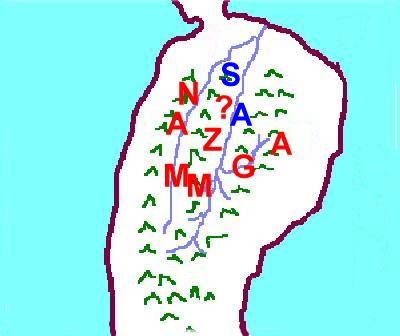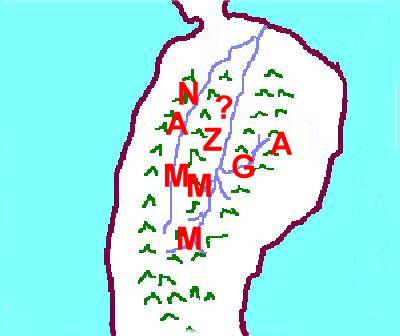Sixth Stage of Colonization and Civilization of Zarahemla
(The North and the South of It. - 120-90 BC)
by Don R. Hender
 Before we cover the southern settlement we will decifer some northern
settlements, These sites are somewhat tenative so I will only place them
temporarily on the map as one's location is not known for sure and
the name of the other is not known. The Book of Mormon mentions the city of
Sidom, but gives it no location. Sidom, marked by the blue 'S' on the map,
was the city that the persecuted saints from Ammonihah fled to for refuge.
(Alma 15:1) I'd suggest a possible site being in a northeastern direction
following the river valley and a distance from Ammonihah and Noah, the two
wicked cities. Assuming Sidom was on the other side of the river, just about
places Sidom between the two rivers in the low lands, being accessible by
both valleys as a possible position for this city.
Before we cover the southern settlement we will decifer some northern
settlements, These sites are somewhat tenative so I will only place them
temporarily on the map as one's location is not known for sure and
the name of the other is not known. The Book of Mormon mentions the city of
Sidom, but gives it no location. Sidom, marked by the blue 'S' on the map,
was the city that the persecuted saints from Ammonihah fled to for refuge.
(Alma 15:1) I'd suggest a possible site being in a northeastern direction
following the river valley and a distance from Ammonihah and Noah, the two
wicked cities. Assuming Sidom was on the other side of the river, just about
places Sidom between the two rivers in the low lands, being accessible by
both valleys as a possible position for this city.
The un-named site is marked by the blue letter 'A' on the map and is in
the land east of the river Sidon. This marks the land in which the people of
Amlici assembled themselves, voted for a king, and prepared for war.
And it came to pass that the people assembled themselves together
throughout all the land, every man according to his mind, whether it were for
or against Amlici, in separate bodies, having much dispute and wonderful
contentions one with another. . . . And it came to pass that they gathered
themselves (the Amlicites) together and did consecrate Amlici to be their king.
. . . And it came to pass that the Amlicites came upon the hill Amnihu which
was east of the river Sidon, which ran by the land of Zarahemla, and there
they began to make war with the Nephites." (Alma 2:5 & 9 & 15)
Since a part of the people assembled themselves together and voted for Amlici
to be King, and since the east side of the river is where they organized their
army, it is assumed they had a land and city in this area below Zarahemla on
the east of the river Sidon.
 When Alma was in pursuit of Amlici and his army, Alma camped for the night
in the mouth of the valley of Gideon and sent 'spies' to follow the army of
Amlici to see where they would go. Amoung the spies was a man named Manti.
There is reason to believe that it was this soldier named Manti that the city
of Manti was named after demoted by the 'M' at the headwaters of the
Sidon/Magdalina River. In the same year but later, after Alma defeated the
combined armies of the Lamanites and Amlicites, there came another Lamanite
army against the Nephites. This Lamanite army did not take Alma and his
people by surprise as did the first Lamanite army that marched with little opposition through the land of Minion almost all the way to the central city of Zarahemla. Now why, when, where, and by whom was the second army of the Lamanites detected before they entered into the central main lands of the Nephites?
When Alma was in pursuit of Amlici and his army, Alma camped for the night
in the mouth of the valley of Gideon and sent 'spies' to follow the army of
Amlici to see where they would go. Amoung the spies was a man named Manti.
There is reason to believe that it was this soldier named Manti that the city
of Manti was named after demoted by the 'M' at the headwaters of the
Sidon/Magdalina River. In the same year but later, after Alma defeated the
combined armies of the Lamanites and Amlicites, there came another Lamanite
army against the Nephites. This Lamanite army did not take Alma and his
people by surprise as did the first Lamanite army that marched with little opposition through the land of Minion almost all the way to the central city of Zarahemla. Now why, when, where, and by whom was the second army of the Lamanites detected before they entered into the central main lands of the Nephites?
Alma, having been caught unprepared once by a Lamanite invasion, certainly
would now take the necessary steps to not be so caught again. Thus, Alma
would have had Manti and others establish an early detection and forewarning
system all the way up in the regions of the headwaters of the Sidon River.
From there any Lamanite movements toward the land of Zarahemla could be
scouted out and detected long before the Lamanites could come into the land
proper by having messengers run the information down to the central lands and
prepare the people. So thus it was, that Manti was above the central land by some distance and there was a sizable wilderness between Manti and the central land of Zarahemla which has been previously discussed. And it is to this time, purpose, location and person that it is looked to, whereby Manti was settled and established.
Manti was a military post city, an outlook city, on the southern border of
the land. One of the unique archeological facts about the Manti or San
Agustin and Tierradentro regions of the upper Sidon, is that it had 'fallout
shelters' which are difficult to find as their entrances were hidden. These
underground shelters are assumed by archeologist to be a form of underground
tomb for burial. A graphic showning one of these, shows eight side chambers
with two central columns left to support the enterior of its structure. The
inner walls are decorated and there have been bones found buried in some of
their floors and some burial urns. A furter description of the structure
follows:
"Cut into the soft rock are large undergound rooms accessible by steep
spiral stairways, the upper end of which is hidden under earth-coverd slabs,
no exterior mark indicating the existence of these burial chambers."
(Colombia, by Prof. G. Reichel-Dolmantoff, page 96)
From understanding Manti's outpost position the 'shelters' may have served for
more than just burial in its floors and for some internment urns. It is
conceivable that when the lookout scouts sighted the enemy, that rather than
fleeing before them, the women and children where ushered into their
underground hiding places while the military held the fort until
reinforcements could arrive. Perhaps some archeologist will stumble across
one of these shelters in the future. And perhaps it will have been
untouched since the time of the Nephites and some direct evidences of the
Nephites from the Nephite times be found. Most all of these evidences are
gone which the Lamanites attempted to completely destroy in their fight of
hatred and extinction against the Nephites.
[Back to Page 1]
[Back to Previous Phase 5]
[Forward to Next Phase 7]
 Before we cover the southern settlement we will decifer some northern
settlements, These sites are somewhat tenative so I will only place them
temporarily on the map as one's location is not known for sure and
the name of the other is not known. The Book of Mormon mentions the city of
Sidom, but gives it no location. Sidom, marked by the blue 'S' on the map,
was the city that the persecuted saints from Ammonihah fled to for refuge.
(Alma 15:1) I'd suggest a possible site being in a northeastern direction
following the river valley and a distance from Ammonihah and Noah, the two
wicked cities. Assuming Sidom was on the other side of the river, just about
places Sidom between the two rivers in the low lands, being accessible by
both valleys as a possible position for this city.
Before we cover the southern settlement we will decifer some northern
settlements, These sites are somewhat tenative so I will only place them
temporarily on the map as one's location is not known for sure and
the name of the other is not known. The Book of Mormon mentions the city of
Sidom, but gives it no location. Sidom, marked by the blue 'S' on the map,
was the city that the persecuted saints from Ammonihah fled to for refuge.
(Alma 15:1) I'd suggest a possible site being in a northeastern direction
following the river valley and a distance from Ammonihah and Noah, the two
wicked cities. Assuming Sidom was on the other side of the river, just about
places Sidom between the two rivers in the low lands, being accessible by
both valleys as a possible position for this city.
 When Alma was in pursuit of Amlici and his army, Alma camped for the night
in the mouth of the valley of Gideon and sent 'spies' to follow the army of
Amlici to see where they would go. Amoung the spies was a man named Manti.
There is reason to believe that it was this soldier named Manti that the city
of Manti was named after demoted by the 'M' at the headwaters of the
Sidon/Magdalina River. In the same year but later, after Alma defeated the
combined armies of the Lamanites and Amlicites, there came another Lamanite
army against the Nephites. This Lamanite army did not take Alma and his
people by surprise as did the first Lamanite army that marched with little opposition through the land of Minion almost all the way to the central city of Zarahemla. Now why, when, where, and by whom was the second army of the Lamanites detected before they entered into the central main lands of the Nephites?
When Alma was in pursuit of Amlici and his army, Alma camped for the night
in the mouth of the valley of Gideon and sent 'spies' to follow the army of
Amlici to see where they would go. Amoung the spies was a man named Manti.
There is reason to believe that it was this soldier named Manti that the city
of Manti was named after demoted by the 'M' at the headwaters of the
Sidon/Magdalina River. In the same year but later, after Alma defeated the
combined armies of the Lamanites and Amlicites, there came another Lamanite
army against the Nephites. This Lamanite army did not take Alma and his
people by surprise as did the first Lamanite army that marched with little opposition through the land of Minion almost all the way to the central city of Zarahemla. Now why, when, where, and by whom was the second army of the Lamanites detected before they entered into the central main lands of the Nephites?